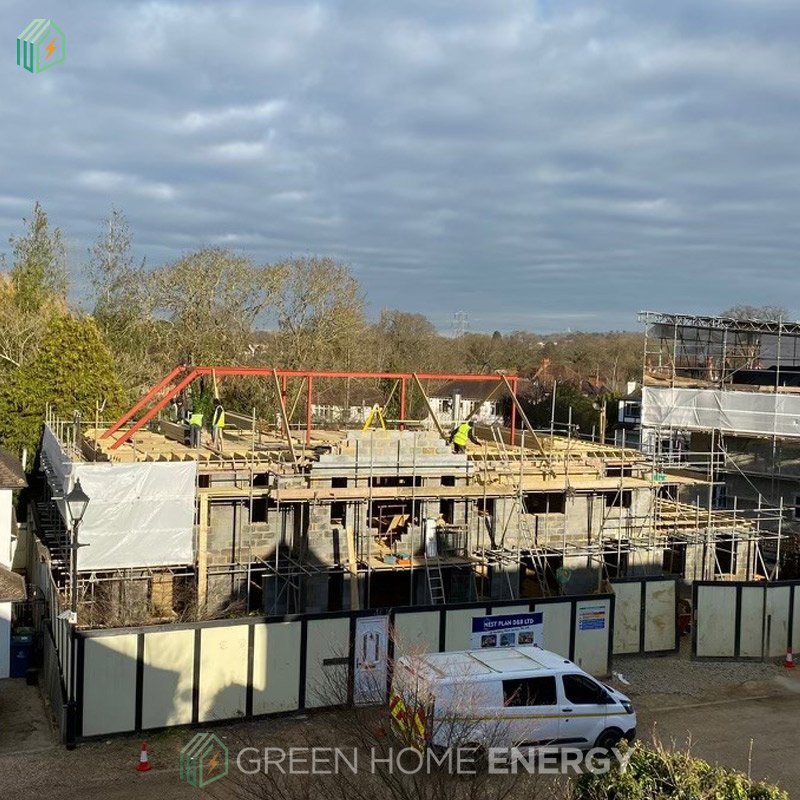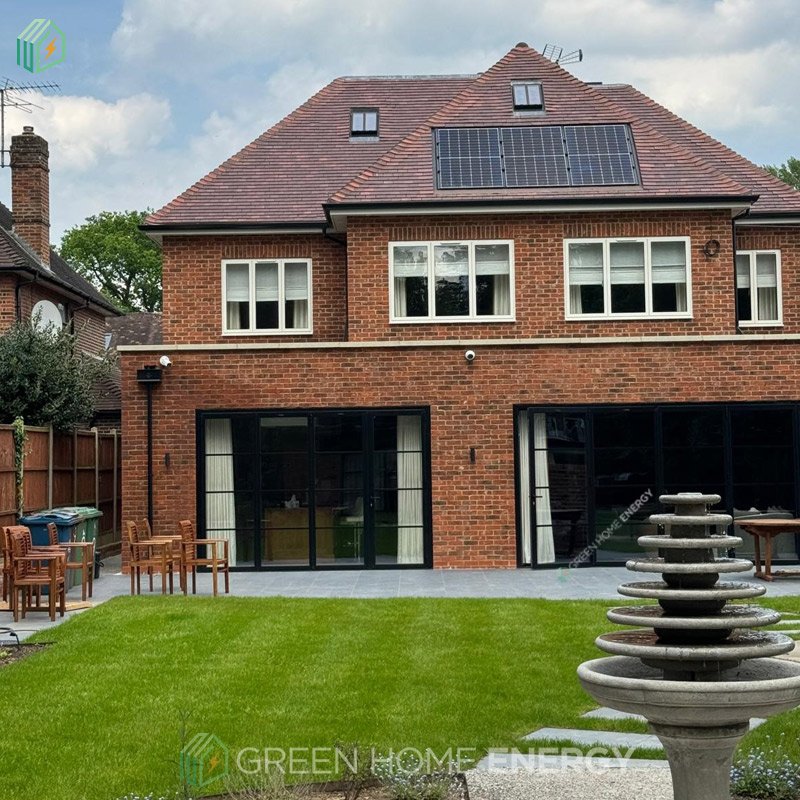Solar Photovoltaic Panels (Solar PV)



The affordable way to reduce your energy bill
Solar energy is the fastest growing renewable energy solution, with 1.7 million homes in the UK going solar by end March 2025. With energy prices at record levels, there has never been a better time to invest in Solar PV and Battery Storage solutions. The recent energy price hikes have increased their cost-effectiveness and made solar panels an even more attractive option for most homeowners to consider.
Power your home with clean, green and cheap electricity directly from the sun. Making the switch to solar energy is a smart move for any homeowner. Solar PV and battery installations are a low-maintenance technology. It is a power plant of your own that pays for itself, increases your property value and lowers your carbon footprint. With electric cars, heating and the world around us becoming more dependent on electricity, it is only a matter of time before there is solar everywhere.
Not only does it save money, Solar PV system is also a more sustainable and environmentally friendly way of producing energy. Advances in technology have made solar much more accessible and cost-effective in recent years. Choosing solar energy makes both financial and environmental sense for anyone looking to reduce their carbon footprint and power their home sustainably. Whatever your requirements we will have a solution that is right for you and your home.
Solar Photovoltaic Systems
Solar Photovoltaic Systems, usually referred to as “Solar PV” or “PV”, are one of the most popular ways to save energy and money. The sun provides an abundant source of clean, renewable energy. This can be converted into electricity using Solar PV panels. Electricity generated by a domestic Solar PV system can be used to power your home, leading to savings on your electricity bills. The sun provides us with more energy than we could ever use, and sunlight cannot be monopolised.
Your solar power system will start saving money from the moment it is turned on; however, the advantages of solar power are best visible in the long-term. The longer you have your solar power system, the more you enjoy the benefits of solar technology and support the environment. The energy saving for each property will depend on the site-specific details including collector tilt, orientation, shading and occupancy.
Solar PV panels are easy to install on rooftops or on the ground without any interference to residential lifestyle. During electricity generation with Solar PV panels there is no harmful greenhouse gas emissions thus Solar PV is environmentally friendly. Solar energy can be made available almost anywhere there is sunlight and have a highly promising future both for economic viability and environmental sustainability.



Low Maintenance, High Efficiency
Solar PV systems offer one of the most cost-effective and hassle-free renewable energy solutions available today. With no moving mechanical parts, except in specific sun-tracking setups, these panels are remarkably durable and require minimal maintenance over time. Completely silent in operation, Solar PV is ideal for residential use and urban environments, delivering clean energy without noise or disruption.
How does solar panels work?
Solar PV systems use cells to convert sunlight into energy. The PV cell consists of one or two layers of a semi conducting material, usually silicon. When light shines directly on to the cells, it creates an electric field across the two layers thus creating the electricity to flow. The greater the intensity of the light, the greater the electricity that is being generated. The solar panels gather electricity and then convert to AC electricity via the inverter. Once this has been converted, you are ready to use the electricity for your home or export back to the grid.
Solar PV can convert almost any day light into electricity, which we can then use for free. Generating your own electricity means that you will be buying less from your utility supplier. As the Solar PV panels have no moving parts there is very little maintenance, noise or operating cost. They provide clean, green, renewable energy with zero emissions from their generation. The systems expected lifetime on most parts is over 25 years and you can sell your excess electricity back to the grid.

Benefits of Solar Photovoltaic System
Reduce your energy bills
There is no single reason that people choose to install Solar PV as the decision is a unique for each individual. Green Home Energy will help you on the journey to make an informed decision to install Solar PV and battery systems. Solar PV system can significantly reduce your dependence on the National Grid, particularly when you include a battery.
Reduce your carbon footprint
You help reduce your carbon footprint in generating your electricity from the sun. That means you will be helping the UK reach Net Zero sooner, which is essential in the battle to fight climate change and slow down global warming.
Boost your property value
Investing in Solar PV and battery storage could increase the value of your property when you want to sell. More and more homeowners are becoming environmentally conscious, so properties with solar installations are increasingly attractive to potential buyers.
Generate an income
Any surplus energy you generate can be sold back to your energy supplier, giving you an extra income thereby reducing your overall energy costs. You can maximise your income by switching to an energy supplier who pays you more.
Types of Solar Photovoltaic installations
On-Roof Solar PV panel systems
On-Roof Solar PV is likely to be one of the more cost-effective options when retrofitting a Solar PV system. Most standard Solar PV panels are supplied with aluminium frames which are designed to be securely attached to prefabricated rails. These rails are then used to secure the whole Solar PV assembly to the roof.


In-Roof Solar PV panel mounting
In-Roof Solar PV mounting systems offer a flush finish where aesthetics is important. There is a large choice of systems that can be used to integrate with most types of roofs. In-Roof mounting can be cost effective when needing to re-roof and for new builds as slates, tiles, etc. will not be needed in the spaces covered by the solar panels.
Flat Roof Solar PV panel mounting
Flat Roof mounting systems can offer a low cost, quick to install and flexible option for mounting Solar PV panels onto flat residential and commercial roof spaces. Tilt angles can often be optimised to make the most from the available space.

Frequently asked questions (FAQs)
Solar PV are photovoltaics panels that produce electricity from solar energy. These are often mounted on the roof and facing towards the Sun. They capture the Sun’s energy and convert it into renewable electricity. This electricity can then be used in our homes, offices as well as commercial premises and any surplus sold to the electricity grid.
The Sun’s energy is converted into DC electricity by Solar PV panels on the roof. An Inverter converts the DC Voltage into AC electricity that we use in our homes and commercial premises. A generation meter records its production. The generated electricity is then used in your home during the daytime. Any excess electricity not used during production is then sold back to your electricity provider or stored in a battery.
In the Northern Hemisphere, Solar PV panels produce their most when facing South, towards the Equator. The Solar PV panels with consistent direct sunlight will produce the most electricity. The angle towards the South, pitch of the roof and shading will affect electricity generation. The Solar PV Panels do not need to face only south or have a perfect pitch to work.
In the UK, south facing solar panels will generate the most energy as they spend the maximum time facing the sun, whereas north facing panels are generally not recommended because they will see little direct sunlight. The Energy Savings Trust estimates that panels facing east or west will yield around 15-20% less energy than one facing directly south. However if you have both an eastern and western facing roof, you have the option to have panels on each side, to follow the sun’s path throughout the day. Whether your roof faces south, east or west your home is perfect to have solar panels fitted. North facing roofs will not receive as much sunlight and therefore will not be as efficient.
South-facing roofs (south-east, south, south-west) are the most efficient for solar panels, but flat roofs and ground-mounted systems are also viable.
Even when it is cloudy, snowing or raining, the Solar PV panels will still generate electricity if it is light outside, although less will be generated than in bright sunshine. The only time the panels will not generate anything is at night time, because the sun is not shining.
We can provide an initial system design in a number of ways, i.e. by using Google Earth or similar Satellite tools or architect drawings provided to us.
The number of Solar PV panels we recommend will depend on the amount of space you have and how much energy you use. The panels are generally 1.8m length x 1.2m width each. We allow circa 40cm gap between the edge of the roof and the panels for In-roof system. In general, the more Solar PV panels on the roof, the more electricity you will generate. However, we will only recommend a large array if your usage is high. We will discuss the options with you.
A roof where water is able to run off the solar panels will be suitable, but a pitched roof is best, as it can provide the best angle for a solar panel to face the sun, without having to use a stand.
It is also important to avoid shady spots on your roof to generate the maximum amount of energy. Shading on a Solar PV panel is a problem, as even one shaded cell could reduce power output of the module or string to zero. Objects as small as a tree branch, a pipe, or a building on the horizon will cause a decline in the possible output of a Solar PV panel. Solar PV systems need to be designed away from shading, or with the shading in mind using appropriate invertors to minimize the effect. Shading certainly should not stop a system being installed, but production calculations will need to be adjusted where shading is affecting the system. This is calculated as part of the free and no obligation design.
Adding Solar PV panels to your home is classed as a “Permitted Development” in the UK and therefore, standard solar panel installations do not require planning permission. Planning permission should be obtained if your home is a listed building, world heritage site or the installation does not meet standard guidelines.
A conservation area is an area of historic or architectural interest that is protected by law. Solar PV Panels cannot be installed where they face, or are in between the property and a public highway. Solar PV panels cannot be installed on or within the boundary of a listed building. If either of the above applied, planning permission would need to be obtained by the customer from their local planning authority. It is the customer responsibility to check and see if they do need any Planning permission.
Solar PV systems are modular and scalable which allows us to fit the correct size system for your needs, without adding to the cost. This is the most important part of the road to Solar PV getting the correct product for you so that your return on investment is maximised. Many companies will try and sell you what they want to sell, not what you need.
The size of a Solar PV system is vital to determining if a rooftop is adequate. It is not just the weight of the Solar PV system that we take into account but also the uplift from wind and snow loading. Details of the existing roof are vital to a sound and long-lasting installation. It is your responsibility to get your roof checked by a structural engineer should you have any doubt or concerns. The responsibility to obtain an independent structural survey or opinion is of the customer. We recommend that you inform your building insurers of the proposed installation of Solar PV. Your insurer may, in some instances, require an additional premium.
The cost of Solar PV system can vary significantly depending on factors such as size of the system and your specific energy requirements.
If you want to install a system larger than 3.68kW then an application has to be made to your DNO. The DNO stands for a Distribution Network Operator. Due to the high output, DNO need to check that it will not cause any load issues on the National Grid. We will establish on the design call if one is required, and if so, will submit this on your behalf.
The payback period is the time in which it takes for you to recoup your initial spend on your Solar PV system. On basis of the typical installation cost and annual bill savings for our most common solar system (10 panels, 5kWh without the battery) in different scenarios, the payback period varied from 8-10 years depending on the energy tariff and own consumption. Of course, each home is unique and this can be influenced by lots of different factors. We will calculate a personalised payback period following our design consultation to give you an insight into what you might save for your home.
According to provisional figures published by the UK Government, as of the end of March 2025 there is a total of 18.1 GW of solar capacity in the UK across 1,760,000 installations. This is an increase of 6.3% (1.1 GW) since March 2024. During March 2025, there were 24,727 installations, accounting for 94 MW of capacity. These volumes remain higher than average figures seen between 2016 and 2021. The median over the past 12 months is over 16,000 installations per month. The bulk of Solar PV installations in the UK are domestic.
Solar Panels produce DC electricity which is different to the AC electricity we use in our homes. An Inverter is installed to convert the DC electricity to match your home’s AC supply. DC (Direct Current) electricity flows in one direction, like a lightning bolt or a battery. AC (Alternating Current) electricity, changes direction multiple times a second. AC is used in our homes because it is safer and easier to transport across great distances.
Often sited in lofts, cooler air is better and most could even be installed in the Plant room or a Garage. Our design team will run over the locations most suitable for your property when you get your quote.
These are intelligent devices that use the excess power generated by Solar PV panels to heat an immersion heater in your hot water cylinder. Electricity not being used by your home can be used to heat a hot water cylinder rather than exporting the electricity to the grid. This can help to save your heat pump from having to turn on,, thus increasing a heat pump’s life and lowering your bills and maintenance. Some can also divert to a second cylinder, an electric towel rail, or even electric underfloor heating.
Yes, any installation beyond one storey building will require scaffolding. Scaffolding is needed to provide safe access to the roof for the installers and also provides a platform for tools and materials to be stored during installation.
The Smart Export Guarantee (SEG) ensures Solar PV generators are paid for the renewable electricity they export to the grid. Since January 1st 2020 applicants can earn money for exporting excess renewable electricity. You can choose the best tariff from competitive Utility Suppliers. In order to receive this export rate the Solar PV system and the installer must be certified under the Microgeneration Certification Scheme (MCS).
If you want to install a system larger than 3.68kW then an application has to be made to your DNO. The DNO stands for a Distribution Network Operator. Due to the high output, DNO need to check that it will not cause any load issues on the National Grid. We will establish on the design call if one is required, and if so, will submit this on your behalf.
String-Inverters are connected to the series of solar panels and convert the entire DC output of the series to AC output. String inverters are typically cheaper, since you only need one for the entire system, and the single inverter means there is a smaller chance of circuit failure. The inverter doesn’t need to be located close to the solar panels, so resistance to heat/ humidity is less of an issue. However, because of the system set up, the total power output is determined by the lowest generating panel. This means that if one panel is in shade, then the total output voltage will be equal to the shaded panel. Whilst this can have a significant effect on the power output of your panels, if your property does not have a problem with shading, it should not put you off using a string inverter system. If your panels are facing multiple angles, or your property has a lot of shaded areas, then this system is unlikely to be right for you.
Micro-Inverters are attached to each individual panel in the system and convert the individual DC output to AC at the solar panel. Microinverters are the best choice for bigger, more complex systems, like having panels on more than one roof plane. Also, if your panels receive partial shade throughout the day, a microinverter will help make the most of your system’s performance. Micro-inverters are located closer to the solar panel system, so need to be designed to be resistant to humidity and heat. Because of this, and the need for multiple inverters, micro-inverters are the higher cost option. Multiple inverters also mean there is a higher chance of circuit failure.
What are Hybrid Inverters? Hybrid Invertors have recently emerged as a method to store solar energy by having a battery charger and converter built into the inverter system. Although more expensive to install than standard inverter systems, stored energy can be helpful for household systems to allow energy use through the evening. However, for businesses that are only operating during daylight hours, a standard string-inverter setup is the more economical choice. These types of inverters require more room and the battery life tends to only be about 10 years.
In conclusion, it really depends on how much you are wanting to spend on your set up, but it is also worth considering whether the extra expense is worth it in your specific case. If you do not have a problem with shading, then you probably do not need to pay extra for a micro-inverter set up. If you do not need to use energy from your solar panels at night time, then it is probably not worth spending money on a hybrid inverter.
You may need to get the freeholders permission to have solar installed on the roof.
The spaces under Solar panels make for the perfect place for pigeons to take refuge! This can cause a host of problems, particularly pigeon droppings damaging the wiring and the build of dirt on the panels which will affect the overall system production. Typically, bird droppings can reduce the efficiency of a panel by up to 30% which can affect your overall yield. Pigeon netting is used to prevent pigeons from using the solar panels on your roof to nest in.
Solar PV systems by design require very little maintenance because there are no moving parts, very little or nothing is needed to enable operation. Panels could need cleaning if debris, droppings or grime gets on the panels. We do not provide this service you can find a local cleaning company who will do this for you.
The angle of the panels ensures that rain and snow will slide right off whilst cleaning them at the same time. Over time, you will need to be aware of anything new shading the panels to make sure you continue to get the very best out of them. To make sure your panels are absorbing as much sunlight as possible, we recommend giving them a clean every now and again – the frequency really depends on where you live, and how dirty they get. If you have a steep roof, you might find that the rain is more than enough to clean your panels so you never have to worry. If you can see dirt on your panels, it is worth speaking to your local window cleaner to find out if they’ll do it for you – but it is important to only use water to clean them as cleaning chemicals can damage the coating.
The performance of Solar PV systems is impossible to predict with certainty due to the variability in the amount of solar radiation (sunlight) from location to location and from year to year. The estimate we provide is based upon procedure as set out in the standards in the MCS New PV Guide v1 and is given as guidance only. It should not be considered as a guarantee of performance.
Let’s connect today
Have a query or need expert guidance on renewable energy solutions? Our friendly team is here to help so contact us and let’s build a greener future together.
SEND US A MESSAGE
CONTACT INFORMATION
Do you have questions about our services & solutions? Send us an email and we’ll get in touch shortly.
Follow Us
Connect with us to discover the latest in green energy, expert tips and exclusive offers. It only takes a second to stay informed and power your home sustainably!








